Cup / Goblet / Porringer
Drinking plays an important role in the enjoyment of life. Browse our collection of sterling silver cups, goblets, beakers, porringers and specialist drinking vessels. An excellent range of early silver examples for the collector which are ideal for practical use and make a perfect gift.
Cups and Trophies, Goblets & Chalices, Beakers & Tumbler Cups
Coconut Cups and Quaiches, Porringers and Bleeding Bowls, Stirrup and Wager Cups
Silver Cups and Trophies. Large size goblets and 2 handled cups are often given as trophy prizes and many have interesting presentation inscriptions. These cups are often used as wine coolers and make fascinating conversation pieces.
Silver Wine Goblets were popular in England during the 17th century until they were superseded by glass drinking vessels in the late 1600s. Silver goblets made a comeback in the mid 18th century and have remained popular ever since. Church communion Chalices can be found dating back to as early as 1560. They sometimes have a cover which doubles as a paten.
Antique Silver Beakers date back to the early 1600s in Europe. They have remained popular up until the present day and are generally of a simple flared form. Sometimes double beakers are found which fit together in the shape of a barrel.
The “Camp Canteen”, dating from the late 17th century onwards, is a travelling set consisting of a beaker fitted inside with cutlery, condiments and possibly a corkscrew.
Silver Tumbler Cups were made from the mid 17th century onwards. They are made from thick gauge sheet silver which was hammered up so that the sides become thinner towards the top and the rounded base would have the greater weight. When they are knocked over they will automatically right themselves. A very useful drinking cup to use onboard ship.
Antique Silver Mounted Coconut Cups. Coconuts were prized in early times for their healing powers and drinking vessels were often formed from them. The coconut cup is a variety of standing cup, made and used in Europe in the 15th and 16th Century, with a revival in Georgian England. Usually they have a pedestal foot or 3 ornamental feet and are mounted in silver or Old Sheffield plate. Many coconuts were carved on board ship by the sailors (or prisoners of war).
Silver Quaiches. Used in Scotland for centuries, the quaiche is a shallow cup with two, or even three, side handles used to drink spirits such as whiskey or brandy. It is a social drinking vessel, symbolic of friendship and trust, which one person would pass to another with both hands (which would render them incapable of holding a secret weapon). In the centre of the basin usually lies a large coin or medallion, often engraved with a coat of arms, a set of initials, a motto, or a toast such as ‘cheers!’ Over the years the quaiche has become a traditional gift at special occasions such as weddings and christenings.
Porringers and Bleeding Bowls. In the past, people from all levels of society took their food in forms unfamiliar today. Everyday nourishment depended heavily on eggs, milk, oats and grains. Ale, sack mead, wine, spices, sultanas and sugar were added for flavor. The gruel, porridge, potage (soup), caudle and other sloppy warm mixtures were partially drunk and partially eaten with a spoon. They were served in 2 handled cups, often with a cover to keep it warm.
Silver Porringers are two handled bowls and some have a cover. They can also be known as caudle cups although the origin of the porringer was for porridge and the caudle cup was for a type of broth. From the eighteenth century onwards, porringers and cups and covers were used mainly as centrepieces or ornaments. In recent times they have seen a resurgence in popularity for drinking and on the dining table. They make a very attractive baby gift.
Silver Bleeding Bowls may have been used for medical purposes however many people think that these shallow bowls were more likely to have been eating vessels, especially for feeding the sick.
Brandy became popular during the 17th century and was consumed from small, lightweight silver Brandy Cups. This spirit was introduced by Dutch traders from Southern France and Spain and was orginally known as “Brandewijn” or “Hottwater”. It was the cheapest alcoholic drink because, unlike wine, ale and cider, it was not taxed until the 1690’s.
Figural Cups, Stirrup Cups and Wager Cups
Silver Stirrup Cups in silver didn’t become popular until the mid 18th century. The name derives from a cup of wine or other alcoholic drink offered to a person on horseback who is about to depart on a journey (with one’s feet in the stirrups). This term is now more associated with the cup used at the traditional fox hunt. The stirrup cup is usually ornamental and often in the form of a fox head.
Silver Wager Cups.
Marriage cups. These highly collectible silver double drinking vessels are also known as marriage cups. The idea is to drink the contents of the large cup (the lady’s skirt) without spilling the drink inside the small cup. The bride would drink from the small cup, the groom from the large cup.
Windmill cups were used as a drinking game. First fill the cup up with a liquor of choice and spin the windmill sails (either by hand or by blowing the horn). The challenge is to drink the contents of the cup before the sails stop. The clock hands on some windmills also revolve with the sails and a penalty would be due depending on the number where the hand (pointer) stopped.”
Cup / Goblet / Porringer
Drinking plays an important role in the enjoyment of life. Browse our collection of sterling silver cups, goblets, beakers, porringers and specialist drinking vessels. An excellent range of early silver examples for the collector which are ideal for practical use and make a perfect gift.
Cups and Trophies, Goblets & Chalices, Beakers & Tumbler Cups
Coconut Cups and Quaiches, Porringers and Bleeding Bowls, Stirrup and Wager Cups
Silver Cups and Trophies. Large size goblets and 2 handled cups are often given as trophy prizes and many have interesting presentation inscriptions. These cups are often used as wine coolers and make fascinating conversation pieces.
Silver Wine Goblets were popular in England during the 17th century until they were superseded by glass drinking vessels in the late 1600s. Silver goblets made a comeback in the mid 18th century and have remained popular ever since. Church communion Chalices can be found dating back to as early as 1560. They sometimes have a cover which doubles as a paten.
Antique Silver Beakers date back to the early 1600s in Europe. They have remained popular up until the present day and are generally of a simple flared form. Sometimes double beakers are found which fit together in the shape of a barrel.
The “Camp Canteen”, dating from the late 17th century onwards, is a travelling set consisting of a beaker fitted inside with cutlery, condiments and possibly a corkscrew.
Silver Tumbler Cups were made from the mid 17th century onwards. They are made from thick gauge sheet silver which was hammered up so that the sides become thinner towards the top and the rounded base would have the greater weight. When they are knocked over they will automatically right themselves. A very useful drinking cup to use onboard ship.
Antique Silver Mounted Coconut Cups. Coconuts were prized in early times for their healing powers and drinking vessels were often formed from them. The coconut cup is a variety of standing cup, made and used in Europe in the 15th and 16th Century, with a revival in Georgian England. Usually they have a pedestal foot or 3 ornamental feet and are mounted in silver or Old Sheffield plate. Many coconuts were carved on board ship by the sailors (or prisoners of war).
Silver Quaiches. Used in Scotland for centuries, the quaiche is a shallow cup with two, or even three, side handles used to drink spirits such as whiskey or brandy. It is a social drinking vessel, symbolic of friendship and trust, which one person would pass to another with both hands (which would render them incapable of holding a secret weapon). In the centre of the basin usually lies a large coin or medallion, often engraved with a coat of arms, a set of initials, a motto, or a toast such as ‘cheers!’ Over the years the quaiche has become a traditional gift at special occasions such as weddings and christenings.
Porringers and Bleeding Bowls. In the past, people from all levels of society took their food in forms unfamiliar today. Everyday nourishment depended heavily on eggs, milk, oats and grains. Ale, sack mead, wine, spices, sultanas and sugar were added for flavor. The gruel, porridge, potage (soup), caudle and other sloppy warm mixtures were partially drunk and partially eaten with a spoon. They were served in 2 handled cups, often with a cover to keep it warm.
Silver Porringers are two handled bowls and some have a cover. They can also be known as caudle cups although the origin of the porringer was for porridge and the caudle cup was for a type of broth. From the eighteenth century onwards, porringers and cups and covers were used mainly as centrepieces or ornaments. In recent times they have seen a resurgence in popularity for drinking and on the dining table. They make a very attractive baby gift.
Silver Bleeding Bowls may have been used for medical purposes however many people think that these shallow bowls were more likely to have been eating vessels, especially for feeding the sick.
Brandy became popular during the 17th century and was consumed from small, lightweight silver Brandy Cups. This spirit was introduced by Dutch traders from Southern France and Spain and was orginally known as “Brandewijn” or “Hottwater”. It was the cheapest alcoholic drink because, unlike wine, ale and cider, it was not taxed until the 1690’s.
Figural Cups, Stirrup Cups and Wager Cups
Silver Stirrup Cups in silver didn’t become popular until the mid 18th century. The name derives from a cup of wine or other alcoholic drink offered to a person on horseback who is about to depart on a journey (with one’s feet in the stirrups). This term is now more associated with the cup used at the traditional fox hunt. The stirrup cup is usually ornamental and often in the form of a fox head.
Silver Wager Cups.
Marriage cups. These highly collectible silver double drinking vessels are also known as marriage cups. The idea is to drink the contents of the large cup (the lady’s skirt) without spilling the drink inside the small cup. The bride would drink from the small cup, the groom from the large cup.
Windmill cups were used as a drinking game. First fill the cup up with a liquor of choice and spin the windmill sails (either by hand or by blowing the horn). The challenge is to drink the contents of the cup before the sails stop. The clock hands on some windmills also revolve with the sails and a penalty would be due depending on the number where the hand (pointer) stopped.”
-

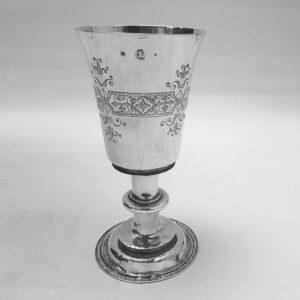
Circa 1574
Lawrence Stratford
10321 Elizabeth I Antique Silver Chalice
Sold
Originating from the English provincial town of Dorchester in Dorset, this fine early English chalice dates to the reign of Elizabeth I. It has the standard design for Elizabethan communion cups with straight tapering sides and a slightly flared top; with wire ornament applied to the stem and hammered egg and dart frieze to the foot. The beautifully hatched decorative bands below the top edge of the cup are typical for the period, they are well executed and with good definition. Most likely this cup has been made from pre-reformation silver and it has the lovely hand beaten finish you’d expect at this date. The removable cover (paten) bears the date of 1574. Superb antique colour.
Contains 250 ml. Chalice weight 231 grams, 7.4 troy oz. Height 20.2cm, diameter of top 9.9cm. Cover weight 55 grams, 1.7 troy oz. Height 2.4cm, diameter 9cm. London c.1574.
Maker’s mark only for Lawrence Stratford. Sterling silver. 16th century. -

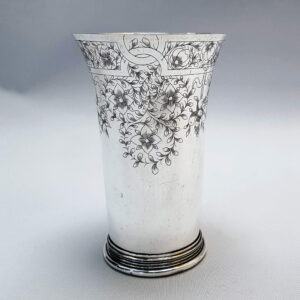
1618
10380 Dutch Antique Silver Beaker
£7,750
A rare example of early Dutch provincial silver. A beautiful antique silver beaker of tall tapering form with a flared rim. Good size and excellent gauge silver. The cup is hand engraved with a strapwork border and fine quality foliate scroll decoration interspersed with flower heads and fruit clusters. The base is scratch engraved with owner’s initials and possibly a date “A.1628”. Contains 600 ml. Weight 255g, 8.2 troy oz. Height 15cm. Diameter 10.2cm (top). Breda, Netherlands. Date1618.
-

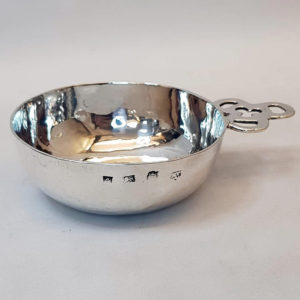
1625
Robert Profit
9989 Charles I Antique Silver Bowl
Sold
An extremely early date. A rare antique silver porringer (or bleeding bowl) of plain circular form. The straight sided shape with a simple rim is the earliest type and in keeping with the early date. Small proportions and very charming with the original hand beaten finish. A useful serving bowl, handy for nuts and sweets. Prick marked on the edge of the rim with the initials “MC”. Weight 108 grams, 3.4 troy ounces. Diameter 10.3cm. Height 3.5 cm. Spread 14cm. London 1625. Maker “RP” possibly Robert Profit (David Mitchell’s “Silversmiths in Elizabethan and Stuart London”).
-

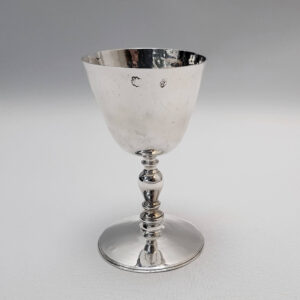
Circa 1630
Daniel Gee
10359 Charles I Antique Silver Wine Cup
£7,950
An exquisite little antique silver cup dating from the early 1600’s. It’s very rare to find a small cup from this date and with such fine proportions. The tapering bowl stands on a knopped stem with a spreading circular foot. Contains 85ml. Weight 115g, 3.6 troy oz. Height 11.7cm. London circa 1630. Maker Daniel Gee. Sterling silver.
-

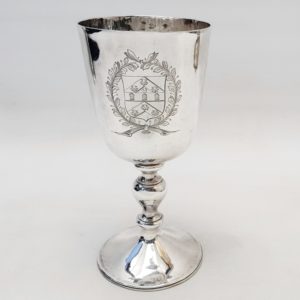
1631
10256 Charles I Antique Silver Cup
Sold
A superb early English silver wine cup of very plain form with a cast baluster stem and spreading foot. This large goblet has an excellent patina, good weight, and sits very well in the hand. To the front is a well-executed armorial for Dr Thomas Eden, hand engraved, the style is typical of the Charles I period with the shield within a laurel-wreath. This is an outstanding piece of antique silver in every way. Contains 430 ml. Weight 326 grams, 10.4 troy ounces. Height 19.8cm. Diameter 9.2cm (top), 9cm (foot). London 1631. Maker “HM”. Sterling silver. 17th century.
-

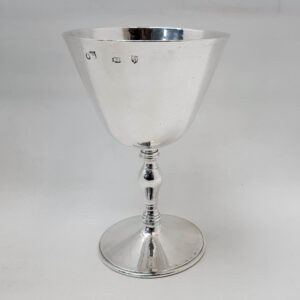
1635
Henry Starkey
10306 Charles I Antique Silver Wine Cup
£18,500
A rare English silver wine cup of very plain form on a cast baluster stem and spreading foot. This goblet has a superb patina and is perfectly styled for use in modern day times with its unusual tapering bowl. The original slightly hand beaten finish is visible on the inside. Contains 300 ml. Weight 207 grams, 6.6 troy ounces. Height 15.8cm. Diameter 10.7cm (top), 8.1cm (foot). London 1635. Maker probably Henry Starkey. Sterling silver. 17th century.
-

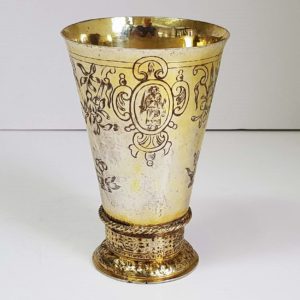
Circa 1650
9680 Antique Dutch Silver Beaker
£4,650
An antique silver beaker of tapering cylindrical form on a cast, coin inset, foot. Bright gilding inside and out. The body is decorated with 3 figures within oval cartouches surrounded by engraved floral and fruit designs. Contains 270 ml. Weight 230 grams, 7.3 troy ounces. Height 13.5cm. Dutch silver marks, possibly Groningen. Maker’s mark 3 anchors. Circa 1650.
-

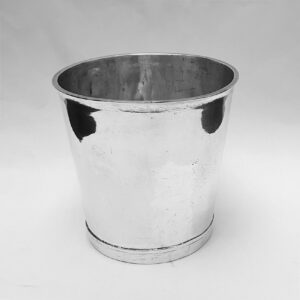
1654
John Winterton
10340 Commonwealth Period Antique Silver Beaker
£2,850
An early English silver drinking cup of small size. Plain tapering design with a turned over lip and simple foot. Contains 240 ml. Weight 63 grams, 2 troy ounces. Height 7cm. Diameter 7.5cm. London 1654. Maker John Winterton. Sterling silver.
-

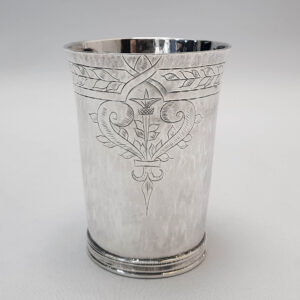
1657
Edward Treen
10416 Commonwealth Antique Silver Beaker
£10,750
A superb antique silver cup dating back to the turbulent mid 1600’s. Of tapering cylindrical form it has a flared rim and simple foot wires. Hand engraved to the top with a band of strapwork interspersed with foliate and scroll motifs. The front is stipple engraved with initials ‘MT’. Fine patina and hand beaten finish. Contains 350ml. Weight 177g, 5.6 troy oz. Height 10.6cm. Diameter of top 8.3cm. London 1657. Maker Edward Treen. Sterling silver.
-

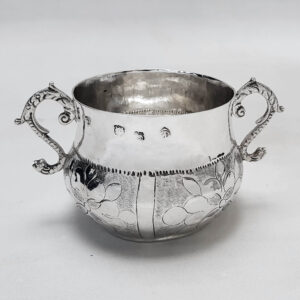
1662
Edward Treen
10339 Charles II Antique Silver Porringer
£2,950
A very early English twin handled silver cup with cast serpent form side handles. This little porringer (or caudle cup) combines some of the austere decoration associated with the Commonwealth period with the addition of hand engraved flowers marking the transition into the joyful Restoration period of Charles II. Superb colour. An attractive feature is the decorative base, very reminiscent of sweetmeat dishes of this period. Contains 250ml. Weight 113 grams, 3.6 troy ounces. Diameter 7.7 cm. Height 7cm (to top of handle). London 1662. Maker Edward Treen, specialist cup, porringer and sweetmeat dish maker. Sterling silver.
-

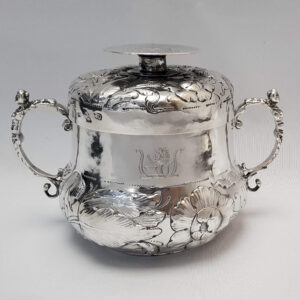
1666
Gowen Udall
10368 Charles II Antique Silver Porringer
Sold
A magnificent piece of early English silver. A large 2 handled antique silver cup and cover with caryatid handles; the body decorated all round with deep relief flowers and foliage typical of this early date. The hand beaten finish is very appealing. The matching cover has a capstan shaped finial so that the lid can be turned upside down and used on its own as a saucer. The lid finial bears a large hand engraved armorial with a crest and motto; the crest is repeated to the front and reverse of the porringer body. The underside has a large presentation inscription dated 1666. Weight 603g, 19.3 troy oz. Spread across handles 20cm. Height 14.5cm (total), 11.2cm (top of handle), 10.5cm (top of body). Diameter 11.8cm. London 1666. Maker probably Gowen Udall – source David Mitchell’s “Silversmiths in Elizabethan and Stuart London”. Sterling silver.
-

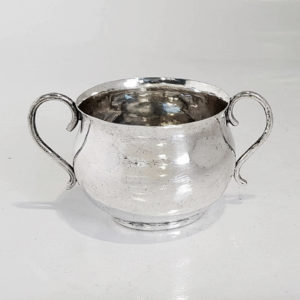
1673
8394 Charles II Antique Silver Brandy Cup
£1,750
A rare early English silver tot cup, or small size porringer, with twin side handles and belly shape. Lovely original hand beaten finish. Lovely original hand beaten finish. Weight 69 grams, 2.2 troy ounces. Height 5.5 cms. Diameter 6 cms. London 1673. Maker IC* listed in Jacksons.
-

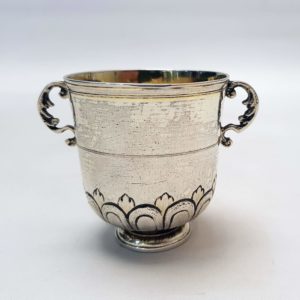
Circa 1674
10260 Antique Augsburg Silver Drinking Tot
£1,650
A delightful little antique silver cup with a faded gilt patina; having cast foliate side handles and decorative motifs to the lower body. Original bright gilt interior. Contains 70ml. Weight 70 grams, 2.2 troy ounces. Height 6cm. Diameter 5.5cm. Made in Augsburg, Germany. Circa 1674. 17th century.
-

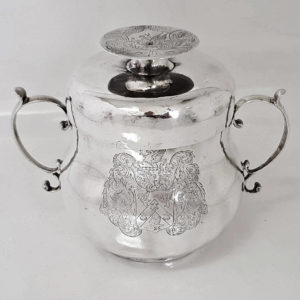
1675
Simon Romney
8739 Antique Charles II Silver Porringer
Sold
A rare piece of early English silver. A large 2 handled antique silver porringer of plain form. The matching cover has a capstan shaped finial so that the lid can be turned upside down and used on its own as a saucer. This has the form of a typical early Restoration porringer, with bellied shape and the lid sitting over the upper rim. There is a small silver support either side next to the handle for the lid to sit on. Hand engraved to the front, and repeated on the cover, are the arms and crest for the Yong family of Medhurst, Sussex. Weight 375 grams, 12 troy ounces. Height 14 cm (total), 10 cm (cup), 4.5 cm (lid). Diameter 10 cm. Spread across the handles 17 cm. London 1675. Makers mark “SR”* in a shield (there are 2 similar marks in Jacksons, see page 124 and 129, bottom of the page), probably Simon Romney.
-

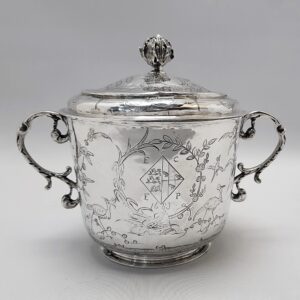
1683
Robert Cooper
10383 Charles II Antique Silver Porringer
£16,500
A rare early English silver cup and cover with finely engraved chinoiserie decoration to the body and lid. Large size and good heavy weight. The fantastical Chinese forest landscape contains exotic long tailed birds and spidery plants depicted in beautiful hand chased ornament. To the front there is a widow’s armorial, owner’s initials, and the date “1683”. The shaped handles are typical of this early period. Weight 575g, 18.4 troy oz. Height 11.2cm (to rim), 17.5cm (to top of finial). Spread 21.8cm. Diameter 14.1cm. London 1683. Maker Robert Cooper. Sterling silver. 17th century.
-

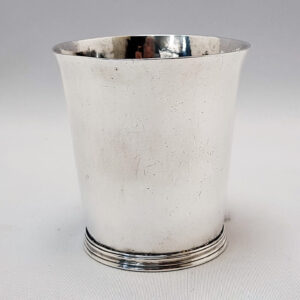
1683
Edward Gladwin
10410 Charles II Antique Silver Beaker
Sold
A handsome early English antique silver beaker of plain, straight sided design having a flared top and simple foot wires. Owner’s initials engraved underneath. Contains 270 ml. Weight 118 grams, 3.7 troy oz. Height 8.7cm. Diameter of top 8.3cm. London 1683. Maker Edward Gladwin – see David Mitchell’s “Silversmiths in Elizabethan and Stuart London”. Sterling silver.
-

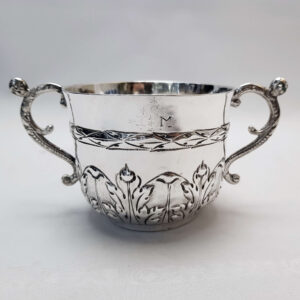
1688
St John Hoyte
10404 Charles II Antique Silver Porringer
£2,250
An early English silver porringer with decorative caryatid handles. Excellent colour. The plain body has an embossed band of acanthus leaf to the lower body. To the front are the prick initials “S over I*M”. Weight 224 grams, 7.2 troy oz. Height 9cm (top of handle). Spread across handles 17.5cm. Diameter 10.5cm. London 1688. Maker St John Hoyte. Sterling silver.
-

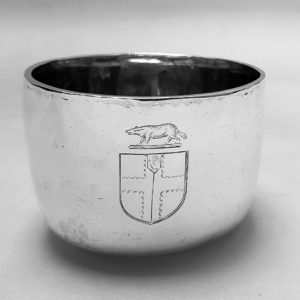
Circa 1690
Katherine Mangy
10186 William and Mary Antique Hull Silver Tumbler Cup
Sold
A rare item of English provincial silver from Hull in the North of England. An antique silver tumbler cup of simple plain design. Good gauge silver and excellent patina. The round and weighted base allows the cup to stay upright when knocked from side to side. This example, typical of Hull silver tumblers, has a flatter base than those made in London. To the front is a hand engraved armorial with a badger crest for the Brooke family. To the reverse are owner’s initials “AD to IS”. Contains 170 ml. Weight 116 grams, 3.7 troy ounces. Height 5.4cm. Diameter 7.3cm. Hull circa 1690. Maker Kath Mangy (Jacksons page 473). Sterling silver.
-

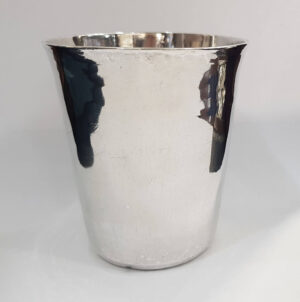
Circa 1690
William Gamble
10293 William and Mary Antique Silver Beaker
£2,750
An early English silver cup with plain tapering sides and rounded base. Contains 350ml. Weight 147 grams, 4.7 troy ounces. Height 9.2cm. Diameter 8.5 (top), 6cm (base). Maker William Gamble. Circa 1690. Sterling silver. 17th century.
-

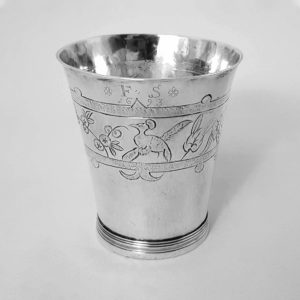
1692
John Richardson
9890 William and Mary Chinoiserie Silver Beaker
Sold
An early English antique silver beaker of plain tapering design with simple foot wires. Dating from the late 1600’s. Compact size. Charmingly decorated with a band of hand chased decoration of birds and foliage in the Chinese style known as “chinoiserie”. To the front there is a hand engraved prick dot design containing “F.S” and the date 1693. Excellent patina and hand beaten finish. Contains 160 ml. Weight 74 grams, 2.3 troy ounces. Height 8.1 cm. Diameter 7.2cm. London 1692. Maker John Richardson, a prominent cup and tankard maker known for chinoiserie silver. Sterling silver.
-

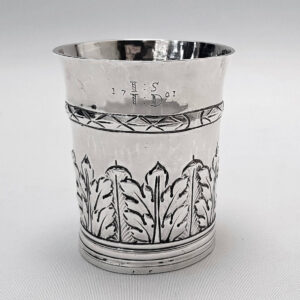
1697
William Andrews
10370 William and Mary Antique Silver Beaker
Sold
A rare early English silver drinking cup of tapering cylindrical form with a flared lip, central band and simple reeded foot. Very attractive size. The lower body has the deep embossed band of acanthus leaves, a popular decoration of the period. Hand engraved to the front are owner’s initials with the date 1701. Contains 150ml. Weight 101g, 3.2 troy oz. Height 7.9cm. Diameter 6.8cm. London 1697. Maker William Andrews. Britannia standard silver – high purity 95.8%.
-

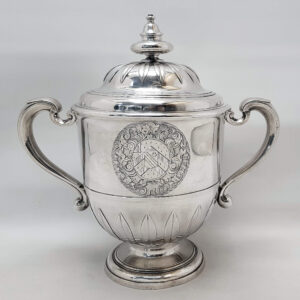
1711
Simon Pantin
10350 Queen Anne Antique Silver Cup and Cover
Sold
A magnificent antique silver cup and cover of campana form with twin side handles. Lovely plain style, very good weight and large size. Excellent quality with the cut card banding typical of this sought after Huguenot maker. Engraved to the front is a large marital coat of arms for Bagot and Wagstaffe contained within a contemporary cartouche; the lid has a goat crest. Total weight 2976g, 95.6 troy oz. Height 32.5cm (to top of lid), 22.2cm (to top of cup rim). Spread across handles 33cm. Diameter of top 19.5cm. London 1711. Maker Simon Pantin. Britannia standard silver.
-

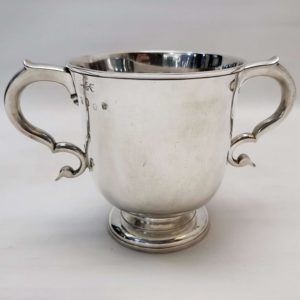
1714
Thomas Port
10248 George I Antique Silver Cup
£2,250
A handsome and very solid antique silver cup of excellent plain form. Extremely heavy gauge. A charming feature is the bird shaped terminal to each of the twin side handles. Weight 646 grams, 20.7 troy ounces. Height 13.5cm. Spread 21cm. Diameter 12.7cm. London 1714. Maker Thomas Port. Britannia standard silver. 18th century.
-

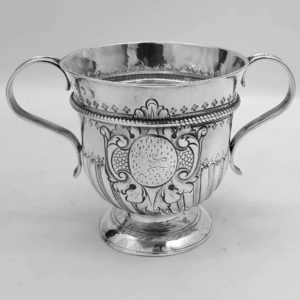
1717
Thomas Parr
9930 George I Silver Porringer
£1,950
A fine antique silver porringer with bands of ribbing to the lower body and a broad rope twist band above. Britannia standard silver*. Good size. Hand engraved to the front within an expansive embossed cartouche, typical of the Queen Anne period, is an armorial crest of a lion. Excellent patina. Contains 930ml. Weight 436 grams, 14 troy ounces. Height 13.8cm. Diameter 13cm. Spread 20.5 cm. London 1717. Maker Thomas Parr.
-

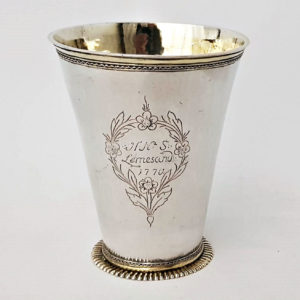
1732
9901 Antique Silver Scandinavian Peg Beaker
£1,850
Possibly Norwegian or Baltic. A rare piece of parcel gilt silver of tapering straight sided form. With bright gilt banding to the foot, rim, and interior. 18th century. Faintly pricked out at the rim with the year “Anno 1732”. To the front is an engraved cartouche with “HNS Lemesand”. While peg tankards are traditional Scandinavian drinking vessels it is very unusual to find a beaker pegged in this fashion. A charming feature is the way that the pegs have been disguised on the front as flower heads. Contains 520 ml. Weight 220 grams, 7ozs. Height 13cm. Diameter 10.9 (top), 7.3cm (base). Stamped underneath with the maker’s mark “FR” double struck. Scandinavian – possibly Norwegian or Baltic. Circa 1732
-

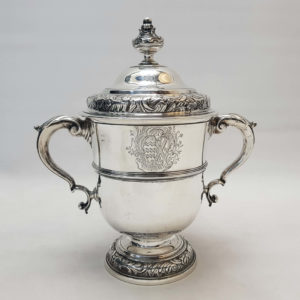
1745
Gabriel Sleath
10188 George II Antique Silver Cup and Cover
Sold
An excellent antique silver cup with matching cover having a traditional campana shape and acanthus leaf side handles. The lid and body have broad bands of embossed shell scrolls with vine leaf and grape ornament. Excellent plain style and very good weight. To the front is a large and finely engraved armorial within a foliate scroll cartouche, the lid with a dog crest. Total weight 1229 grams, 39.5 troy ounces. Cup 855 grams, 27.4 troy ounces. Lid 374 grams,12 troy ounces. Height 26cm (to top of lid finial), 13cm (to top of cup rim). Spread across handles 23.2cm. Diameter of top 13cm. London 1745. Maker Gabriel Sleath. 18th century.
-

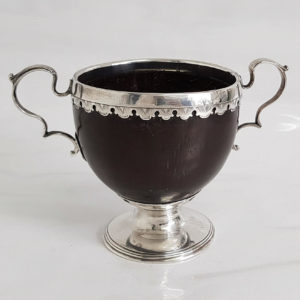
Circa 1750
9923 Antique Silver Coconut Cup
Sold
A very charming piece of antique silver. The coconut cup is mounted with an engraved and scalloped silver rim and a low spreading silver foot. The very nice period features include the heart shaped supports at the base of the twin side handles and the little flower shaped nut attaching the silver foot to the coconut. Height 9.2cm (rim), 9.8cm top of (handle). Diameter 8.3cm. Makers mark only “MF” double struck. Probably English circa 1750.
-

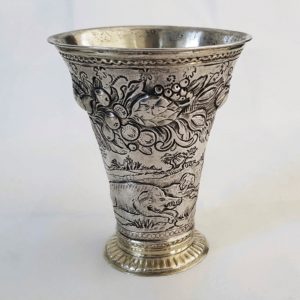
Circa 1750
Modin
9929 Antique Swedish Silver Beaker
£950
Of sporting interest. An antique silver beaker of tapering form, the lower body is embossed and chased all round with a boar hunting scene. Small size. Gilded to the top rim, base and interior. Contains 150 ml. Weight 57 grams, 1.8 troy ounces. Height 8.9cm. Diameter 7.5c, (top), 4.4cm (base). Stamped underneath with Swedish silver marks for Sundersvall. Maker J.P Modin. Circa 1750.
-

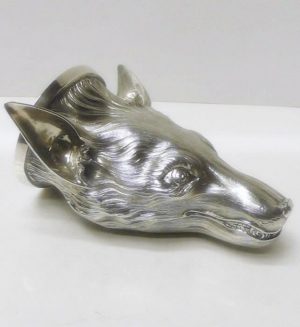
1773
John Lautier
8086 George III Silver Fox Stirrup Cup
Sold
A beautifully modelled antique sterling silver stirrup cup in the form of a fox head. Fine features and lovely expressive face. Weight 147 grams, 4.7 troy ounces. Length 11.5 cm. Width 10 cm. English silver hallmarks on the rim for London 1773. Maker John Lautier.
-

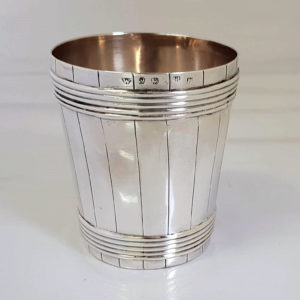
1784
George Walker I
9849 George III Silver Beaker
£1,450
A very nice piece of English provincial silver. This rare antique silver beaker, of barrel form, has 2 concentric bands and vertical line engraving to represent the pieces of wood forming the barrel. Underneath are the engraved initials S.M.D. Contains 175ml. Weight 101g, 3.2 troy oz. Height 7.5cm. Diameter 6.5cm. Chester 1784. Maker George Walker I. Sterling silver.
-

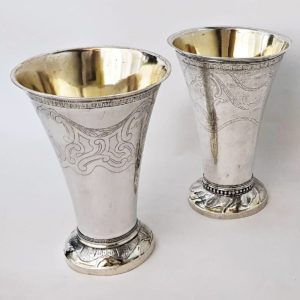
1796
Erik Ernander
9907 Antique Silver Swedish Vases
£1,950
A large harlequin pair of antique silver vases, or ale glasses, with gilded bands to the top and base rims, and fully gilded interior. Each has an expansive band of engraved decoration to the body, one vase with initials “C.O.D” prick engraved to the front. Very similar in weight and size, the vases have differing decorations. Total weight 771 grams (381/390), 24.7 troy ounces. Height 20.7/20.4cm. Diameter 14.5/14.3cm. Swedish silver stamps. Maker E. Ernander. Date mark O2 for 1796.
-

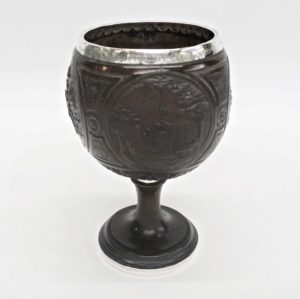
Circa 1800
9255 Antique Silver Coconut Cup
£950
An antique silver mounted coconut cup on a tall spreading foot. Good size and condition. The bowl is profusely carved and the four vignettes show 1) crowned monogram, 2) a mountain scene with houses in the foreground, a river and bridge, 3) a forest scene with a monument surrounded by a bird, dog and lamb 4) a carved still life roundel. There is a silver mount to the top and base, and there is also a shaped collar where the base meets the cup. The top mount has an inscription. Contains 400 ml. Height 15.5 cm. Diameter 8 cm. Unmarked. Probably continental, circa 1800.
Recently Viewed Products
-

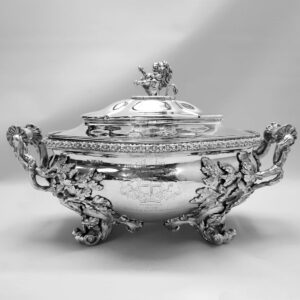
1829
Thomas Wimbush
10406 George IV Antique Silver Soup Tureen
£12,500
An outstanding antique silver tureen with matching domed cover. Large and impressive; excellent size for serving soup, casseroles and vegetables. Fantastic weight and very fine quality. The oval bellied shape is applied with stunning cast silver handles and oak and acorn foliate shaped feet; the lid handle is cast in the form of a lion rampant. Hand engraved armorials to the front and reverse of the body and lid for the Honorable East India Company and the Bosanquet family. Heavy gauge silver. Good colour. Weight 4,735g, 152.2 troy oz. Spread across handles 43cm. Height 26cm (total, 23cm (top of handle). London 1829. Maker Thomas Wimbush. Sterling silver.
-

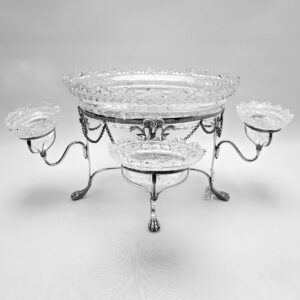
1807
Mary Troby
10408 George III Antique Silver Table Centrepiece
£3,500
An elegant antique silver centerpiece complete with matching suite of contemporary cut crystal bowls. Plain oval shape with 4 detachable arms, classical ram’s heads with looped chains, and paw feet. The glass bowls can be used separately. The weight of silver is 1297 grams, 41.7 troy ounces. Height 24.25 cms. Spread 47 cms. Bowls 29.5 x 20.5/13 x 9 cms. All pieces marked London 1807. Maker Mary Troby. Sterling silver.